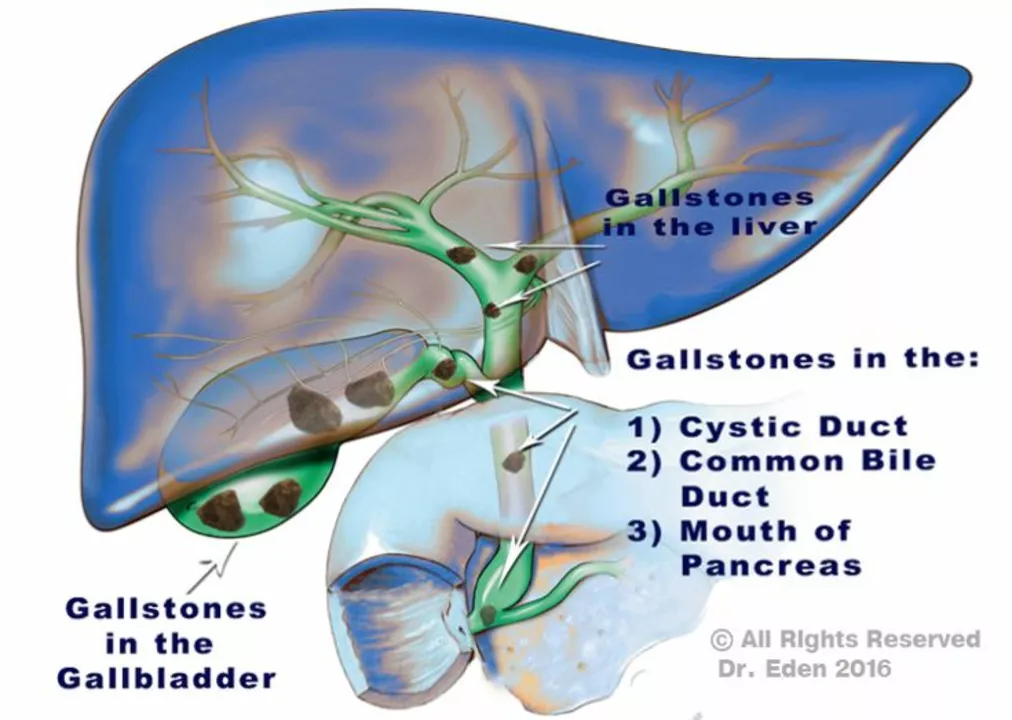Gallstones: Causes, Symptoms, Treatment, and What to Do Now
About 10–15% of adults will form gallstones at some point. Most never know it, but when a stone blocks a bile duct you can get intense upper-right belly pain that ruins your day — or worse. Want quick, practical steps? Read on.
Gallstones are hardened bits that form in the gallbladder. There are two main types: cholesterol stones (the most common) and pigment stones. Stones can sit quietly or move and block bile flow, which causes pain, inflammation, infection, or jaundice.
Risk factors are easy to remember: being female, older age, overweight, and rapid weight loss all raise the chance. Other risks include certain medications, pregnancy, diabetes, and a family history of gallstones. Knowing your risks helps you and your doctor decide how closely to watch symptoms.
Typical symptoms include a steady, sharp ache under the right ribs or center of the upper belly, often after fatty meals. Pain can last from 30 minutes to several hours and may spread to the back or right shoulder. Nausea and vomiting are common. If you get fever, chills, dark urine, pale stools, or yellowing of the eyes/skin, that suggests a blocked bile duct or infection — get urgent care.
How doctors check for gallstones
The first test is usually an abdominal ultrasound — fast, painless, and accurate at finding stones in the gallbladder. Blood tests check liver enzymes and white blood cells to spot inflammation or blockage. If the ultrasound is unclear or ducts are involved, your doctor may order CT, MRCP (a special MRI for bile ducts), or ERCP, which can both diagnose and remove stones from the common bile duct.
Not every stone needs treatment. If you have no symptoms, many people do fine without any procedure. But repeated pain, inflammation, or complications usually lead to surgery. The standard is laparoscopic cholecystectomy (removal of the gallbladder) — most patients go home the same day or next day and recover within one to two weeks. Some people experience mild diarrhea at first as the body adjusts.
Treatment tips and prevention you can use
For pain, NSAIDs like ibuprofen are often the first choice; opioids are used for severe attacks. Ursodeoxycholic acid is a medication that can dissolve small cholesterol stones, but it works slowly and only in select cases. ERCP is the go-to when stones block the bile duct — it removes the stone without open surgery.
To lower your risk, keep a stable, healthy weight, avoid crash diets, eat a fiber-rich diet with moderate healthy fats, and stay active. If you’re losing weight, aim for gradual loss. After gallbladder removal, start with smaller, lower-fat meals until digestion adapts.
If you have severe, ongoing abdominal pain, fever, or yellowing skin, don’t wait — seek medical care. Questions about surgery or medicines? Talk to your doctor so you get a plan that fits your health and lifestyle.

The Gallbladder Cleanse: Fact or Fiction in Treating Gallstones?
- by Colin Edward Egan
- on 29 May 2023
In my latest blog post, I explored the controversial topic of the gallbladder cleanse and its effectiveness in treating gallstones. After researching various sources, it seems that the medical community remains divided on this issue. Some believe that a gallbladder cleanse can help to flush out gallstones, while others argue that it's simply a myth. As someone who values evidence-based practices, I would advise my readers to consult with their healthcare provider before attempting any type of cleanse. It's important to remember that everyone's body is different and what may work for one person may not be suitable for another.
